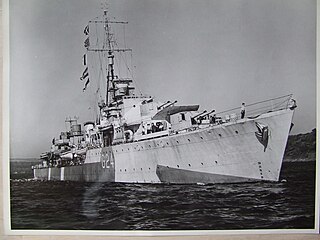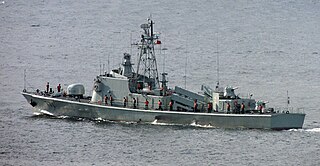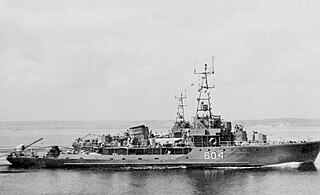
A cruiser is a type of warship. Modern cruisers are generally the largest ships in a fleet after aircraft carriers and amphibious assault ships, and can usually perform several roles.

High-speed transports were converted destroyers and destroyer escorts used in US Navy amphibious operations in World War II and afterward. They received the US Hull classification symbol APD; "AP" for transport and "D" for destroyer.

The Royal Ordnance L7, officially designated Gun, 105 mm, Tank, L7, is the basic model of the United Kingdom's most successful tank gun. The L7 is a 105 mm L/52 rifled design by the Royal Ordnance Factories intended for use in armoured fighting vehicles, replacing the earlier QF 20-pounder (84 mm) tank gun mounted on the Centurion tank. The successful L7 gun has been fitted on many armoured vehicles including the British Centurion, the German Leopard 1 and early variants of the US M1 Abrams.

A radar picket is a radar-equipped station, ship, submarine, aircraft, or vehicle used to increase the radar detection range around a nation or military force to protect it from surprise attack, typically air attack, or from criminal activities such as smuggling. By definition a radar picket must be some distance removed from the anticipated targets to be capable of providing early warning. Often several detached radar units would be placed to encircle a target to provide increased cover in all directions; another approach is to position units to form a barrier line.
"Destroyer minesweeper" was a designation given by the United States Navy to a series of destroyers that were converted into high-speed ocean-going minesweepers for service during World War II. The hull classification symbol for this type of ship was "DMS." Forty-two ships were so converted, beginning with USS Dorsey (DD-117), converted to DMS-1 in late 1940, and ending with USS Earle (DD-635), converted to DMS-42 in mid-1945. The type is now obsolete, its function having been taken over by purpose-built ships, designated as "minesweeper (high-speed)" with the hull classification symbol MMD.

HMCS Huron was a Tribal-class destroyer that served in the Royal Canadian Navy in the Second World War and the Korean War. She was the first ship to bear this name, entering service in 1943. She was named for the Huron people. During the Second World War the vessel saw service in Operation Neptune in the Bay of Biscay and along the French coast in support of the invasion of Normandy and escorted convoys to the Soviet Union. Following the war, the ship was placed in reserve. The destroyer was activated in 1950 as a training ship, but with the onset of the Korean War, was modernized and deployed twice to Korea. Following the war, Huron reverted to a training ship and took part in Cold War-era North Atlantic Treaty Organization (NATO) naval exercises until being paid off for the final time in 1963 and broken up for scrap in 1965.

The Type 062 gunboat is a class of gunboat of the People's Liberation Army Navy first developed and constructed in the 1950s. This unsophisticated class is relatively well-armed for its size and is the most widely built and exported Chinese naval vessel in terms of numbers. A total of 30 were built, initial boats being known as the Shanghai I class and later slightly improved boats being known as the Shanghai II class. The Shanghai I class was slightly smaller than its successor, the Shanghai II class, displacing 125 tons instead of 135 tons, and had a twin Chinese Type 66 57 mm gun mount forward. All other specifications are identical to the Shanghai II class, which replaced the 57 mm with twin 37 mm gun mounts. Some boats remained in active service well into the early 1990s in the PLA navy and longer in the case of the Korean People's Navy.

The Type 025 torpedo boat, also known as the Huchuan or Hu Chwan class, was once the backbone of the People's Liberation Army Navy (PLAN) in its confrontations with its much larger opponents in the Republic of China Navy. Although no longer serving in that capacity, this class is still active. While relatively unsophisticated, the class has enjoyed a longevity in active service thanks to a philosophy within PLAN which has continued to favor its use. Powered by Soviet-era engines, the hydrofoil-equipped boats are capable of 50 knots and carry two torpedo tubes for torpedoes, with some known to be armed with naval mines.

The Type 037 corvette is a series 400–500 ton corvette type classes in service with the People's Liberation Army Navy. Unlike western navies, the People's Liberation Army Navy does not have dedicated patrol boats in its inventory. Instead, a large variety of corvette type classes, in the form of missile boats and submarine chasers fulfill the tasks of patrolling China's territorial waters. The Egyptian Navy operates eight vessels.

The Myanmar Navy is the naval warfare branch of the armed forces of Myanmar. With 24,000 personnel on duty, the navy operates more than 150 vessels. Prior to 1988, the navy was small, and its role in counter-insurgency operations was smaller than those of the army and the air force. The navy has since been expanded to take on a more active role in defense of Myanmar's territorial waters.

Naval trawlers are vessels built along the lines of a fishing trawler but fitted out for naval purposes; they were widely used during the First and Second World Wars. Some—known in the Royal Navy as "Admiralty trawlers"— were purpose-built to naval specifications, others adapted from civilian use. Fishing trawlers were particularly suited for many naval requirements because they were robust vessels designed to work heavy trawls in all types of weather, and had large clear working decks. A minesweeper could be created by replacing the trawl with a mine sweep. Adding depth charge racks on the deck, ASDIC below, and a 3-inch (76 mm) or 4-inch (102 mm) gun in the bow equipped the trawler for anti-submarine duties.

The Battle of Someri was a battle in the Gulf of Finland during World War II on 8–9 July 1942, between the Soviet Union and Finland. Starting as a modest operation to clear a Finnish observation post from a small island, it became one of the largest surface ship engagements in the Baltic theater.

The Rizal class was a ship class of two patrol corvettes formerly operated by the Philippine Navy. These ships were formerly used by the US Navy as Auk class minesweepers. Under the Philippine Navy, the two vessels have undergone upgrades and modification, and were categorized as corvettes.

The T43 class were a group of minesweepers built for the Soviet Navy and Soviet allies in the 1950s and 1960s. The Soviet designation was Project 254.
The T58 class were a group of minesweepers built for the Soviet Navy in the 1950s. The Soviet designation was Project 264.
Type 912 degaussing/deperming ship is a class of degaussing/deperming ship of the People's Liberation Army Navy (PLAN) with many derivatives. Type 912 is also the most numerous degaussing/deperming ship in PLAN.
HMCS Bellechasse was a Bangor-class minesweeper constructed for the Royal Canadian Navy during the Second World War. The minesweeper entered service in 1941 and spent the entire war on the West Coast of Canada. Sold in 1946 for mercantile conversion, the conversion was not carried out and Bellechasse was broken up for scrap instead.
HMCS Wasaga was a Bangor-class minesweeper constructed for the Royal Canadian Navy during the Second World War. Entering service in 1941, the minesweeper took part in the Battle of the Atlantic and the invasion of Normandy. Following the end of the war, the vessel was sold in 1946 and broken up for scrap in 1947.
HMCS Kelowna was a Bangor-class minesweeper constructed for the Royal Canadian Navy during the Second World War. Entering service in 1942, the minesweeper spent the entire war on the West Coast of Canada, mainly as a patrol vessel. Following the war, Kelowna was sold for mercantile conversion. Renamed Hung Hsin and Condor, the final disposition of the vessel is disputed.
HMCS Swift Current was a Bangor-class minesweeper that served with the Royal Canadian Navy during the Second World War. Entering service in 1941, the warship used as a training ship and convoy escort and took part in the battles of the St. Lawrence and the Atlantic. Following the war the ship was laid up until reacquired during the Korean War. Never re-entering service with Canada, Swift Current was sold to the Turkish Navy in 1958. Renamed Bozcaada, the minesweeper was discarded in 1971.













